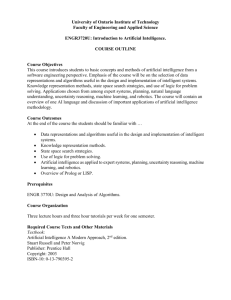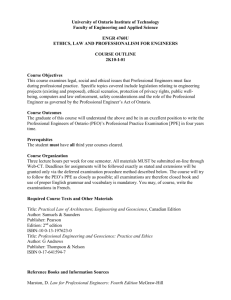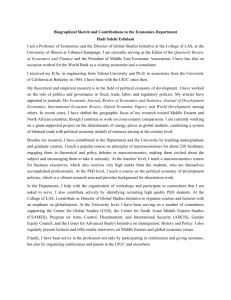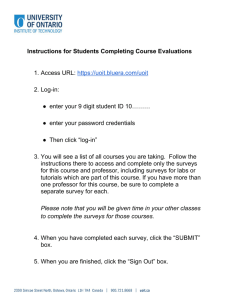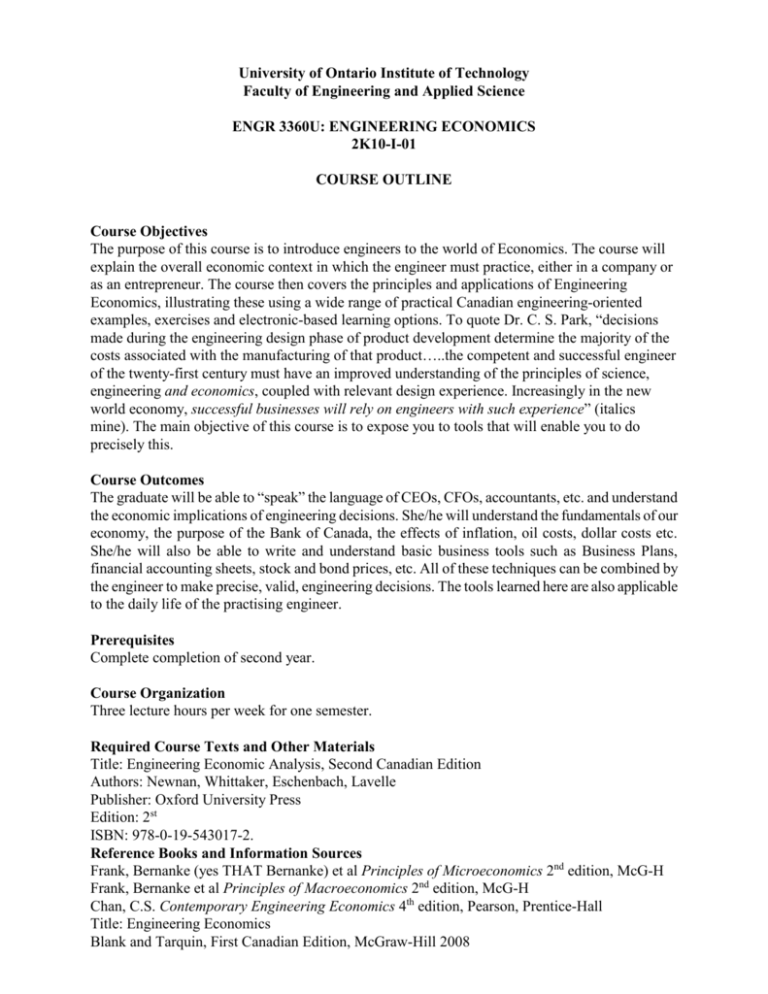
University of Ontario Institute of Technology
Faculty of Engineering and Applied Science
ENGR 3360U: ENGINEERING ECONOMICS
2K10-I-01
COURSE OUTLINE
Course Objectives
The purpose of this course is to introduce engineers to the world of Economics. The course will
explain the overall economic context in which the engineer must practice, either in a company or
as an entrepreneur. The course then covers the principles and applications of Engineering
Economics, illustrating these using a wide range of practical Canadian engineering-oriented
examples, exercises and electronic-based learning options. To quote Dr. C. S. Park, “decisions
made during the engineering design phase of product development determine the majority of the
costs associated with the manufacturing of that product…..the competent and successful engineer
of the twenty-first century must have an improved understanding of the principles of science,
engineering and economics, coupled with relevant design experience. Increasingly in the new
world economy, successful businesses will rely on engineers with such experience” (italics
mine). The main objective of this course is to expose you to tools that will enable you to do
precisely this.
Course Outcomes
The graduate will be able to “speak” the language of CEOs, CFOs, accountants, etc. and understand
the economic implications of engineering decisions. She/he will understand the fundamentals of our
economy, the purpose of the Bank of Canada, the effects of inflation, oil costs, dollar costs etc.
She/he will also be able to write and understand basic business tools such as Business Plans,
financial accounting sheets, stock and bond prices, etc. All of these techniques can be combined by
the engineer to make precise, valid, engineering decisions. The tools learned here are also applicable
to the daily life of the practising engineer.
Prerequisites
Complete completion of second year.
Course Organization
Three lecture hours per week for one semester.
Required Course Texts and Other Materials
Title: Engineering Economic Analysis, Second Canadian Edition
Authors: Newnan, Whittaker, Eschenbach, Lavelle
Publisher: Oxford University Press
Edition: 2st
ISBN: 978-0-19-543017-2.
Reference Books and Information Sources
Frank, Bernanke (yes THAT Bernanke) et al Principles of Microeconomics 2nd edition, McG-H
Frank, Bernanke et al Principles of Macroeconomics 2nd edition, McG-H
Chan, C.S. Contemporary Engineering Economics 4th edition, Pearson, Prentice-Hall
Title: Engineering Economics
Blank and Tarquin, First Canadian Edition, McGraw-Hill 2008
Newnan, Whittaker, Eschenbach, Lavelle Engineering Economics, OUP
Fraser, Jewkes, Bernhardt, Tajma Engineering Economics in Canada, 3rd edition Pearson, PrenticeHall
Loads more in the library.
Course Evaluation: You MUST pass the final examination to pass the course. . If you cannot
write the midterm and/or the final because of sickness, etc., then the following procedure must be
followed:
Medical certificates MUST be sent DIRECTLY from the Doctor’s Office or Hospital within 5
days by mail or preferably by fax (3370) to the Academic Advisor of FEAS.
A fee for the deferral must be paid by the student if the Medical certificate is valid and
arrives on time.
Failure to comply with the above will result in an F for the mid-term and/or the final exam.
The deferred exam will be oral.
Business Plan
InClass Quizleins
Problem Sets
Midterm Test Mar 02 In Class
Final Examination
Total
10%
10%
20%
20%
40%
100%
Detailed Course Content
- Part 0 General Economic Background
0.1 Aspects of theoretical and applied economics relevant to engineers, including an
introduction to fundamental principles of micro- and macroeconomics.
0.2 Microeconomics topics include scarcity, opportunity cost, diminishing returns,
elasticity, industrial organization, economies of scale and concentration.
0.3 Macroeconomics topics include unemployment, inflation, economic growth, the
multiplier, equilibrium, fiscal policy and monetary policy.
0.4 The principle of money and banking are introduced along with the role of the
Bank of Canada.
- Part 1 Engineering Economics
1 Foundations of engineering economics
2 Time value of money
3 Combining factors
4 Interest rates
5 Present worth analysis
6 Annual worth analysis
7 Rate of return analysis, single
8 Rate of return analysis, multiple
9 Benefit-cost analysis and public sector economics
10 Making choices
11 Replacement decisions
12 Selecting from independent projects
13 Breakeven analysis
14 Effects of inflation
15 Depreciation methods
16 After-tax economic analysis
17 Sensitivity analysis
18 Risk analysis
Computer Experience
Use of Excel and Excel macros.
Course Content Breakdown:
Mathematics:
00%
Basic Science:
00%
Engineering Science:
00%
Engineering Design:
00%
Complementary Studies:
100%
Total:
100%
Other Information
There will be handouts of exercises showing Canadian examples.
Professor
Dr. Michael Bennett, P.Eng, PMP
Teaching Assistant
Ms. Behnaz Rezaie
SOME IMPORTANT GENERAL INFORMATION OF RELEVANCE TO THE COURSE
Academic Integrity and Conduct
UOIT is committed to the fundamental values of preserving academic integrity as defined in
UOIT policies and contained in the UOIT Calendar. Students should familiarize themselves with
UOIT’s policies and statements in this area. Acts of academic dishonesty, including plagiarism,
cheating, aiding others in cheating, and examination impersonation, will be dealt with severely as
they threaten the integrity of the academic system and are not acceptable.
UOIT and faculty members reserve the right to use electronic means to detect and help prevent
plagiarism. Students agree that by taking this course all assignments are subject to submission for
textual similarity review to Turnitin.com. Assignments submitted to Turnitin.com will be
included as source documents in Turnitin.com's restricted access database solely for the purpose
of detecting plagiarism in such documents for five academic years. The faculty member may
require students to submit their assignments electronically to Turnitin.com or the faculty member
may submit questionable text on behalf of a student. The terms that apply to UOIT's use of the
Turnitin.com service are described on the Turnitin.com website. (To read the entire policy, please
go to: http://www.uoit.ca/EN/main2/11246/13525/14057/14152/turnitin_policy.html.)
Accessibility
To insure that disability-related concerns are properly addressed during this course, students with
documented disabilities and who may require assistance to participate in this class are
encouraged to speak with their instructor as soon as possible. Students who suspect they may
have a disability that may effect their participation in this course are advised to go to the Centre
for Students with Disabilities (room B297) as soon as possible.
Approved by
Dr. J. Michael Bennett, PEng, PMP, Associate Dean, FEAS, Undergraduate and Accreditation
Date: Sep 01, 2K9

